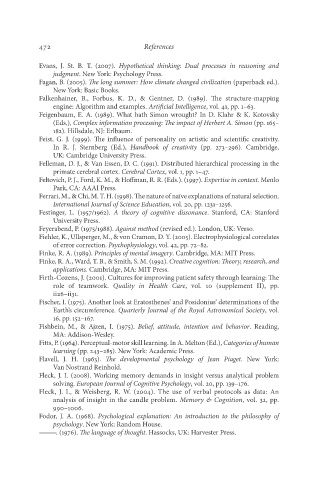Page 489 - Deep Learning
P. 489
472 References
Evans, J. St. B. T. (2007). Hypothetical thinking: Dual processes in reasoning and
judgment. New York: Psychology Press.
Fagan, B. (2005). The long summer: How climate changed civilization (paperback ed.).
New York: Basic Books.
Falkenhainer, B., Forbus, K. D., & Gentner, D. (1989). The structure-mapping
engine: Algorithm and examples. Artificial Intelligence, vol. 41, pp. 1–63.
Feigenbaum, E. A. (1989). What hath Simon wrought? In D. Klahr & K. Kotovsky
(Eds.), Complex information processing: The impact of Herbert A. Simon (pp. 165–
182). Hillsdale, NJ: Erlbaum.
Feist, G. J. (1999). The influence of personality on artistic and scientific creativity.
In R. J. Sternberg (Ed.), Handbook of creativity (pp. 273–296). Cambridge,
UK: Cambridge University Press.
Felleman, D. J., & Van Essen, D. C. (1991). Distributed hierarchical processing in the
primate cerebral cortex. Cerebral Cortex, vol. 1, pp. 1–47.
Feltovich, P. J., Ford, K. M., & Hoffman, R. R. (Eds.). (1997). Expertise in context. Menlo
Park, CA: AAAI Press.
Ferrari, M., & Chi, M. T. H. (1998). The nature of naïve explanations of natural selection.
International Journal of Science Education, vol. 20, pp. 1231–1256.
Festinger, L. (1957/1962). A theory of cognitive dissonance. Stanford, CA: Stanford
University Press.
Feyerabend, P. (1975/1988). Against method (revised ed.). London, UK: Verso.
Fiehler, K., Ullsperger, M., & von Cramon, D. Y. (2005). Electrophysiological correlates
of error correction. Psychophysiology, vol. 42, pp. 72–82.
Finke, R. A. (1989). Principles of mental imagery. Cambridge, MA: MIT Press.
Finke, R. A., Ward, T. B., & Smith, S. M. (1992). Creative cognition: Theory, research, and
applications. Cambridge, MA: MIT Press.
Firth-Cozens, J. (2001). Cultures for improving patient safety through learning: The
role of teamwork. Quality in Health Care, vol. 10 (supplement II), pp.
ii26–ii31.
Fischer, I. (1975). Another look at Eratosthenes’ and Posidonius’ determinations of the
Earth’s circumference. Quarterly Journal of the Royal Astronomical Society, vol.
16, pp. 152–167.
Fishbein, M., & Ajzen, I. (1975). Belief, attitude, intention and behavior. Reading,
MA: Addison-Wesley.
Fitts, P. (1964). Perceptual-motor skill learning. In A. Melton (Ed.), Categories of human
learning (pp. 243–285). New York: Academic Press.
Flavell, J. H. (1963). The developmental psychology of Jean Piaget. New York:
Van Nostrand Reinhold.
Fleck, J. I. (2008). Working memory demands in insight versus analytical problem
solving. European Journal of Cognitive Psychology, vol. 20, pp. 139–176.
Fleck, J. I., & Weisberg, R. W. (2004). The use of verbal protocols as data: An
analysis of insight in the candle problem. Memory & Cognition, vol. 32, pp.
990–1006.
Fodor, J. A. (1968). Psychological explanation: An introduction to the philosophy of
psychology. New York: Random House.
———. (1976). The language of thought. Hassocks, UK: Harvester Press.

